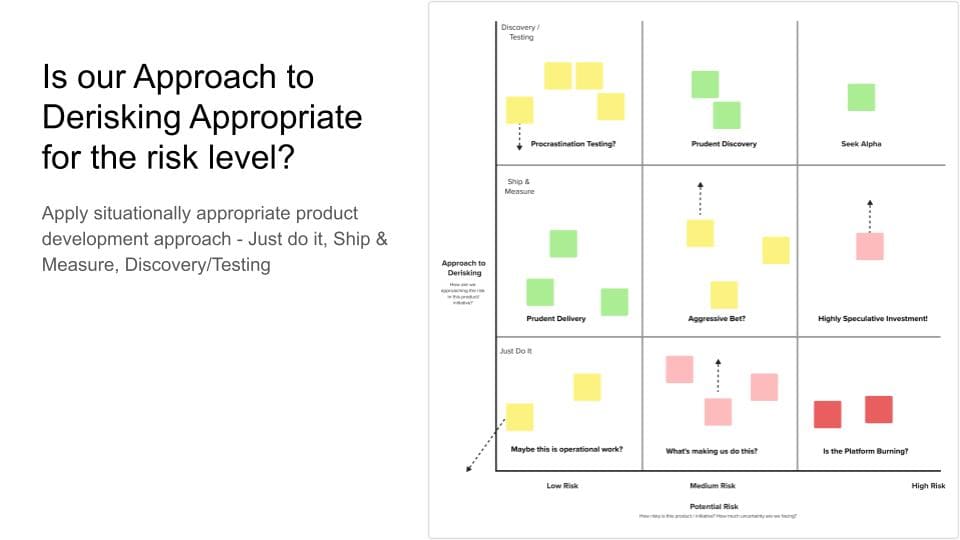Executives keep hearing that “95 percent of AI projects fail.”
The truth is uglier: it’s not the models that are failing, it’s the management operating systems we’re using to leverage them.
Most organizations treat AI like a project — scope, budget, work breakdown structure, milestones. But looking for ways to leverage/operationalize AI is prime example of high potential with high uncertainty. Will this be a practical use case? Is it feasible? Viable?

Managing such work like a project often results in nasty surprises – projects don’t deliver on time, and even when they do, they fail to make an impact.
The Hidden Bottleneck: Your Operating System
Think of how you manage strategic projects in your organization:
- Crawl – It’s so chaotic, it’s impossible to deliver even a pretty stable project.
- Sit – We deliver stable projects through professional project management and accountability (e.g. through a PMO, adopting EOS). High-potential, high-risk projects are still a crapshoot.
- Walk – We can deliver high-technical/feasibility-risk projects through effective collaboration and fast feedback loops. Some of these projects provide the promised outcomes, but some of the most strategic ones don’t.
- Run – This is the holy grail. We are able to maximize returns and minimize investment even for high-potential high-risk investments by leveraging derisking mechanisms, whether the risk is implementation, need, or total cost of ownership.
When leaders pull me in for advice, I see distinct differences between product-focused initiatives and the rest.
Most organizations have learned they need to walk and run when it comes to their product/tech initiatives. But when it comes to other initiatives, even this taxonomy is foreign to most company-level PMOs and leaders.
What happens when you plug AI into this environment?
Companies that are working to leverage AI in their products are doing reasonably well. There’s plenty to learn and do when it comes to designing, developing, and maintaining AI features, as well as leveraging AI to accelerate product development, but product/tech organizations are at least aware of what they should be aiming for.
This is true when integrating AI capabilities into your internally focused products and systems as well.
The challenge arises when organizations try to leverage AI beyond the boundaries of their traditional IT. It’s these use cases that have high potential but often fail miserably because they’re not managed properly.
Apply Product Thinking to AI
Organizations that do find gold with AI borrow habits from great product teams:
- Start with a problem, not a technology.
Ask, “Where would we hire AI to move the needle?” not “Which tool should we buy?” - Work in bounded, outcome-driven loops.
Treat AI efforts like products with clear hypotheses, customers, and measures of success. - Continuously develop context.
The more clarity you give teams about constraints, users, and success criteria, the smarter their experimentation becomes. Context is the real training data.
At a BioTech firm I worked with, for example, scientific teams used Scrum-like loops to test how AI models could accelerate gene-therapy design. The secret wasn’t better algorithms; it was better empiricism — visible hypotheses, short learning cycles, and shared evidence across disciplines.
Upgrading the Company, Not Just the Code
You don’t need to replace your entire operating system, but you do need to upgrade it for learning speed. Ask yourself:
- Are strategic initiatives expressed as outcomes or projects?
- Do our scorecards show leading indicators we can steer with, or lagging ones we report after the fact?
- How often do we inspect and adapt our bets based on evidence, not hope?
The Real Playbook
The organizations turning AI into business impact share one discipline: agility. Not the capital-A flavor with ceremonies and roles, but the practice of aligning, inspecting, adapting, and flowing work toward outcomes.
They learn faster, and pivot cheaper. They’ve moved from projects to products way beyond the classic boundary of the product/tech organization.
AI isn’t a silver bullet. It’s a forcing function. It exposes how slowly our organizations learn.
Before you invest in more models, invest in an operating system that can think and adapt like one.